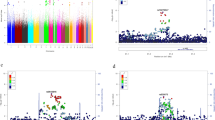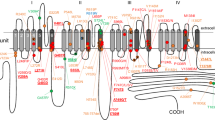Abstract
ORAI1 encodes a calcium channel essential in the store-operated calcium entry mechanism. A previous genetic association study identified a rare in-frame insertion variant of ORAI1 conferring Kawasaki disease (KD). To deepen our understanding of the involvement of rare variants of ORAI1 in KD pathogenesis, we investigated 3812 patients with KD and 2644 healthy individuals for variations in the protein-coding region of ORAI1. By re-sequencing the study participants’ DNA, 27 variants with minor allele frequencies (MAFs) < 0.01 that had not been examined in the previous study were identified. Although no significant association with KD was observed either in single-variant analyses or in a collapsing method analysis of the 27 variants, stratification by MAFs, variant types, and predicted deleteriousness revealed that six rare, deleterious, missense variants (MAF < 0.001, CADD C-score ≥ 20) were exclusively present in KD patients, including three refractory cases (OR = ∞, P = 0.046). The six missense variants include p.Gly98Asp, which has been demonstrated to result in gain of function leading to constitutive Ca2+ entry. Conversely, five types of frameshift variants, all identified near the N terminus and assumed to disrupt ORAI1 function, showed an opposite trend of association (OR = 0.35, P = 0.24). These findings support our hypothesis that genetic variations causing the upregulation of the Ca2+/NFAT pathway confer susceptibility to KD. Our findings also provide insights into the usefulness of stratifying the variants based on their MAFs and on the direction of the effects on protein function when conducting association studies using the gene-based collapsing method.
Similar content being viewed by others
Login or create a free account to read this content
Gain free access to this article, as well as selected content from this journal and more on nature.com
or
Change history
31 July 2019
An amendment to this paper has been published and can be accessed via a link at the top of the paper
References
Kawasaki T. Acute febrile mucocutaneous syndrome with lymphoid involvement with specific desquamation of the fingers and toes in children. Arerugi. 1967;16:178–222.
Burns JC. Commentary: translation of Dr. Tomisaku Kawasaki’s original report of fifty patients in 1967. Pediatr Infect Dis J. 2002;21:993–5.
Onouchi Y, Tamari M, Takahashi A, Tsunoda T, Yashiro M, Nakamura Y, et al. A genome-wide linkage analysis of Kawasaki disease: evidence for linkage to chromosome 12. J Hum Genet. 2007;52:179–90.
Onouchi Y, Gunji T, Burns JC, Shimizu C, Newburger JW, Yashiro M, et al. ITPKC functional polymorphism associated with Kawasaki disease susceptibility and formation of coronary artery aneurysms. Nat Genet. 2008;40:35–42.
Onouchi Y, Ozaki K, Burns JC, Shimizu C, Hamada H, Honda T, et al. Common variants in CASP3 confer susceptibility to Kawasaki disease. Hum Mol Genet. 2010;19:2898–906.
Onouchi Y, Fukazawa R, Yamamura K, Suzuki H, Kakimoto N, Suenaga T, et al. Variations in ORAI1 gene associated with Kawasaki disease. PLoS One. 2016;11:e0145486.
Prakriya M, Feske S, Gwack Y, Srikanth S, Rao A, Hogan PG. ORAI1 is an essential pore subunit of the CRAC channel. Nature. 2006;443:230–3.
Vig M, Peinelt C, Beck A, Koomoa DL, Rabah D, Koblan-Huberson M, et al. CRACM1 is a plasma membrane protein essential for store-operated Ca2+ entry. Science. 2006;312:1220–3.
Feske S, Gwack Y, Prakriya M, Srikanth S, Puppel SH, Tanasa B, et al. A mutation in Orai1 causes immune deficiency by abrogating CRAC channel function. Nature. 2006;441:179–85.
Trebak M, Zhang W, Ruhle B, Henkel MM, González-Cobos JC, Motiani RK, et al. What role for store-operated Ca2+ entry in muscle? Microcirculation. 2013;20:330–6.
Kurebayashi N, Ogawa Y. Depletion of Ca2+ in the sarcoplasmic reticulum stimulates Ca2+ entry into mouse skeletal muscle fibres. J Physiol. 2001;533:185–99.
Sung YJ, Korthauer KD, Swartz MD, Engleman CD. Methods for collapsing multiple rare variants in whole-genome sequence data. Genet Epidemiol. 2014;38:13–20.
Kircher M, Witten DM, Jain P, O’Roak BJ, Cooper GM, Shendure J. A general framework for estimating the relative pathogenicity of human genetic variants. Nat Genet. 2014;46:310–5.
Baba Y, Kurosaki T. Impact of Ca2+ signaling on B cell function. Trends Immunol. 2011;32:589–94.
Félix R, Crottès D, Delalande A, Fauconnier J, Lebranchu Y, Le Guennec JY, et al. The Orai-1 and STIM-1 complex controls human dendritic cell maturation. PLoS One. 2013;8:e61595.
Steinckwich N, Schenten V, Melchior C, Bréchard S, Tschirhart EJ. An essential role of STIM1, Orai1, and S100A8-A9 proteins for Ca2+ signaling and FcγR-mediated phagosomal oxidative activity. J Immunol. 2011;186:2182–91.
Maul-Pavicic A, Chiang SC, Rensing-Ehl A, Jessen B, Fauriat C, Wood SM, et al. ORAI1-mediated calcium influx is required for human cytotoxic lymphocyte degranulation and target cell lysis. Proc Natl Acad Sci USA. 2011;108:3324–9.
Tolhurst G, Carter RN, Amisten S, Holdich JP, Erlinge D, Mahaut-Smith MP. Expression profiling and electrophysiological studies suggest a major role for Orai1 in the store-operated Ca2+ influx pathway of platelets and megakaryocytes. Platelets. 2008;19:308–13.
Baba Y, Nishida K, Fujii Y, Hirano T, Hikida M, Kurosaki T. Essential function for the calcium sensor STIM1 in mast cell activation and anaphylactic responses. Nat Immunol. 2008;9:81–8.
Onouchi Y, Suzuki Y, Suzuki H, Terai M, Yasukawa K, Hamada H, et al. ITPKC and CASP3 polymorphisms and risks for IVIG unresponsiveness and coronary artery lesion formation in Kawasaki disease. Pharm J. 2013;13:52–9.
Suzuki H, Terai M, Hamada H, Honda T, Suenaga T, Takeuchi T, et al. Cyclosporin A treatment for Kawasaki disease refractory to initial and additional intravenous immunoglobulin. Pediatr Infect Dis J. 2011;10:871–6.
Aoyagi R, Hamada H, Sato Y, Suzuki H, Onouchi Y, Ebata R, et al. Study protocol for a phase III multicentre, randomised, open-label, blinded-end point trial to evaluate the efficacy and safety of immunoglobulin plus cyclosporin A in patients with severe Kawasaki disease (KAICA Trial). BMJ Open. 2015;5:e009562.
Zhang SL, Yeromin AV, Hu J, Amcheslavsky A, Zheng H, Cahalan MD. Mutations in Orai1 transmembrane segment 1 cause STIM1-independent activation of Orai1 channels at glycine98 and channel closure at arginine91. Proc Natl Acad Sci USA. 2011;108:17838–43.
Zheng H, Zhou M-H, Hu C, Kuo E, Peng X, Hu J, et al. Differential roles of the C and N termini of Orai1 protein in interacting with stromal interaction molecule 1 (STIM1) for Ca2+ release-activated Ca2+ (CRAC) channel activation. J Biol Chem. 2013;288:11263–72.
Shahrizaila N, Lowe J, Wills A. Familial myopathy with tubular aggregates associated with abnormal pupils. Neurology. 2004;63:1111–3.
Endo Y, Noguchi S, Hara Y, Hayashi YK, Motomura K, Miyatake S, et al. Dominant mutations in ORAI1 cause tubular aggregate myopathy with hypocalcemia via constitutive activation of store-operated Ca2+ channels. Hum Mol Genet. 2015;24:637–48.
Boehm J, Bulla M, Urquhart JE, Malfatti E, Williams SG, Sullivan JO, et al. ORAI1 mutations with distinct channel gating defects in tubular aggregate myopathy. Hum Mutat. 2017;38:426–38.
Fukushima M, Tomita T, Janoshazi A, Putney JW. Alternative translation initiation gives rise to two isoforms of Orai1 with distinct plasma membrane mobilities. J Cell Sci. 2012;125:4354–61.
Li B, Leal SM. Methods for detecting associations with rare variants for common diseases: application to analysis of sequence data. Am J Hum Genet. 2008;83:311–21.
McCarthy MI, Abecasis GR, Cardon LR, Goldstein DB, Little J, Ioannidis JP, et al. Genome-wide association studies for complex traits: consensus, uncertainty and challenges. Nat Rev Genet. 2008;9:356–69.
Manolio TA, Collins FS, Cox NJ, Goldstein DB, Hindorff LA, Hunter DJ, et al. Finding the missing heritability of complex diseases. Nature. 2009;461:747–53.
Richards S, Aziz N, Bale S, Bick D, Das S, Gastier-Foster J, et al. Standards and guidelines for the interpretation of sequence variants: a joint consensus recommendation of the American College of Medical Genetics and Genomics and the Association for Molecular Pathology. Genet Med. 2015;17:405–24.
Garibaldi M, Fattori F, Riva B, Labasse C, Brochier G, Ottaviani P, et al. A novel gain-of-function mutation in ORAI1 causes late-onset tubular aggregate myopathy and congenital miosis. Clin Genet. 2017;91:780–86.
Nesin V, Wiley G, Kousi M, Ong EC, Lehmann T, Nicholl DJ, et al. Activating mutations in STIM1 and ORAI1 cause overlapping syndromes of tubular myopathy and congenital miosis. Proc Natl Acad Sci USA. 2014;111:4197–202.
McCarl CA, Picard C, Khalil S, Kawasaki T, Rother J, Papolos A, et al. ORAI1 deficiency and lack of store-operated Ca2+ entry cause immunodeficiency, myopathy, and ectodermal dysplasia. J Allergy Clin Immunol. 2009;124:1311–8.
Chou J, Badran YR, Yee CSK, Bainter W, Ohsumi TK, Al-Hammadi S, et al. A novel mutation in ORAI1 presenting with combined immunodeficiency and residual T-cell function. J Allergy Clin Immunol. 2015;136:479–82.
Badran YR, Massaad MJ, Bainter W, Cangemi B, Naseem SU, Javad H, et al. Combined immunodeficiency due to a homozygous mutation in ORAI1 that deletes the C-terminus that interacts with STIM1. Clin Immunol. 2016;166–7:100–2.
Lian J, Cuk M, Kahlfuss S, Kozhaya L, Vaeth M, Rieux-Laucat F, et al. ORAI1 mutations abolishing store-operated Ca2+ entry cause anhidrotic ectodermal dysplasia with immunodeficiency. J Allergy Clin Immunol. 2018;142:1297–310.
den Dunnen JT, Antonarakis SE. Mutation nomenclature extensions and suggestions to describe complex mutations: a discussion. Hum Mutat. 2000;15:7–12.
Acknowledgements
This study was supported by grants from the Millennium Project, Japan Kawasaki Disease Research Center (2009 to YO), the Ministry of Education, Culture, Sports, and Technology (25293139 to YO), the Ministry of Health, Labour and Welfare (0401040 to AH), and the Japan Agency for Medical Research and Development (JP17ek0410039 to TH). We are grateful to the participants in this study and the medical staff caring for the patients. We also thank Ms. Yoshie Kikuchi for her technical assistance.
Japan Kawasaki Disease Genome Consortium
Hiroshi Masuda7, Tohru Kobayashi7, Toshiaki Jibiki8, Taro Yamazaki9, Yoshiaki Ohkuma10, Maya Fujiwara11, Tomio Kobayashi12, Harumitsu Takeuchi13, Kazunobu Ouchi14, Yumi Mizuno15, Shigeto Fuse16, Nobuhiro Fukazawa17, Tsutomu Saji18, Shinichi Takatsuki18, Kenichiro Nishimura19, Hiromichi Hamada20, Ryuji Fukazawa21, Hideko Nishumura22, Kentaro Aso23, Tomoyo Matsubara24, Takahisa Mizuno25, Satoru Iwashima26, Mamoru Ayusawa27, Kazuyuki Ikeda28, Takashi Kosuda29, Kunio Hashimoto30, Kunio Hirasawa31, Masaru Miura32, Junpei Somura33, Emi Toba34, Keiichi Hirono35, Yuichi Nomura36, Hirokazu Arakawa37, Shouhei Ogata38, Hiroki Kajino39, Seiji Kawamura40, Hayato Aoyagi41, Hiroshi Suzuki42, Kouta Ichinose43, Ayako Shimozono44, Yoshiaki Kato45, Masamune Higashikawa46, Youichi Kawamura47, Masahiro Misawa48, Noriko Nagai49, Taichi Kato50, Dan Nagata51, Akiko Okamoto52, Hiroyuki Suzuki53, Masahiko Kishiro54, Junko Shiono55, Kouji Higashi56, Naoki Yokoyama57, Ryota Ebata58, Yoshihiro Onouchi59.
Author information
Authors and Affiliations
Consortia
Corresponding author
Ethics declarations
Conflict of interest
The authors declare that they have no conflict of interest.
Additional information
Publisher’s note: Springer Nature remains neutral with regard to jurisdictional claims in published maps and institutional affiliations.
Members of the Japan Kawasaki Disease Genome Consortium are listed in Acknowledgements.
Rights and permissions
About this article
Cite this article
Thiha, K., Mashimo, Y., Suzuki, H. et al. Investigation of novel variations of ORAI1 gene and their association with Kawasaki disease. J Hum Genet 64, 511–519 (2019). https://doi.org/10.1038/s10038-019-0588-2
Received:
Revised:
Accepted:
Published:
Issue Date:
DOI: https://doi.org/10.1038/s10038-019-0588-2
This article is cited by
-
Circulating CD3+HLA-DR+ Extracellular Vesicles Are Not Increased in the Acute Phase of Kawasaki Disease
SN Comprehensive Clinical Medicine (2020)
-
Immunogenetics of Kawasaki disease
Clinical Reviews in Allergy & Immunology (2020)



